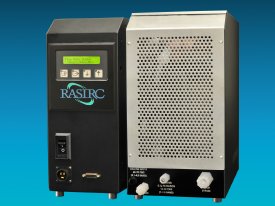May 26 2011
RASIRC®, the steam purification company, announced that its RASIRC Steamers were found by the Fraunhofer Institute for Solar Energy Systems (ISE) to yield 20.2% efficiency in the production of back-contact silicon solar cells. Fraunhofer used the Steamer to deliver ultrapure water vapor for both its metal wrap through (MWT) and passivated emitter and rear cell (PERC) solar cell manufacturing processes.
Fraunhofer's goal is to increase solar photovoltaic (PV) cell efficiency, thereby maximizing the amount of sunlight that can be converted into electricity. New solar cell concepts based on industrial-level production processes, such as the RASIRC Steamer, are being explored. Fraunhofer ISE is the largest solar energy research institute in Europe.

The RASIRC Steamer removes volatiles, ionic contaminants, and other impurities from steam generated from DI water so the steam can be used for critical solar cell manufacturing processes. Yield is increased because metals, hydrocarbons, and particles are rejected by the non-porous membrane to deliver steam with purity in the parts per trillion (ppt). Throughput is increased with continuous unattended 24/7 operation. Compared to pyrolytic torches, there is no thermal build-up with increased flow rate, it's safer as hydrogen and oxygen are eliminated from the oxidation process, it operates at significantly lower temperature, and handles a wide range of pressures and flow rates.
Fraunhofer applies both MWT and PERC processes for increasing efficiency in its solar cells. In the MWT concept, the external front-contacts are transferred to the backside of the solar cell. As a result, more sunlight is incident on the front surface and the solar cell efficiency increases. In the PERC concept, both the optimized reflection of the solar cell backside as well as passivation of the rear surface contribute to higher efficiencies. The screen-printed aluminum back-contact is connected to the p-type silicon material using local laser alloying -- the so-called Laser Fired Contact (LFC) process.
"It has been a very productive and positive experience working with the engineers from Fraunhofer ISE," said Jeffrey Spiegelman, president of RASIRC. "It is very exciting to be an important part in bringing MWT/PERC cells to mass production."